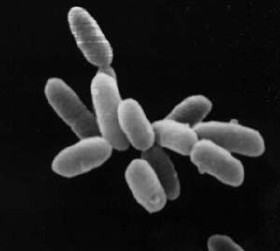
Halobacterium is a genus in the family Halobacteriaceae.
Halobacteriaceae is a family in the order Halobacteriales and the domain Archaea. Halobacteriaceae represent a large part of halophilic Archaea, along with members in two other methanogenic families, Methanosarcinaceae and Methanocalculaceae. The family consists of many diverse genera that can survive extreme environmental niches. Most commonly, Halobacteriaceae are found in hypersaline lakes and can even tolerate sites polluted by heavy metals. They include neutrophiles, acidophiles, alkaliphiles, and there have even been psychrotolerant species discovered. Some members have been known to live aerobically, as well as anaerobically, and they come in many different morphologies. These diverse morphologies include rods in genus Halobacterium, cocci in Halococcus, flattened discs or cups in Haloferax, and other shapes ranging from flattened triangles in Haloarcula to squares in Haloquadratum, and Natronorubrum. Most species of Halobacteriaceae are best known for their high salt tolerance and red-pink pigmented members, but there are also non-pigmented species and those that require moderate salt conditions. Some species of Halobacteriaceae have been shown to exhibit phosphorus solubilizing activities that contribute to phosphorus cycling in hypersaline environments. Techniques such as 16S rRNA analysis and DNA–DNA hybridization have been major contributors to taxonomic classification in Halobacteriaceae, partly due to the difficulty in culturing halophilic Archaea.

Halobacteriales are an order of the Halobacteria, found in water saturated or nearly saturated with salt. They are also called halophiles, though this name is also used for other organisms which live in somewhat less concentrated salt water. They are common in most environments where large amounts of salt, moisture, and organic material are available. Large blooms appear reddish, from the pigment bacteriorhodopsin. This pigment is used to absorb light, which provides energy to create ATP. Halobacteria also possess a second pigment, halorhodopsin, which pumps in chloride ions in response to photons, creating a voltage gradient and assisting in the production of energy from light. The process is unrelated to other forms of photosynthesis involving electron transport; however, and halobacteria are incapable of fixing carbon from carbon dioxide.
Haladaptatus is a genus of halophilic archaea in the family of Halobacteriaceae. The members of Haladaptatus thrive in environments with salt concentrations approaching saturation
Halalkalicoccus is a genus of the Halobacteriaceae.

Haloarcula is a genus of extreme halophilic Archaea in the class of Halobactaria.
Halobaculum is a genus of the Halorubraceae.
Halobiforma is a genus of halophilic archaea of the family Natrialbaceae.

Haloferax is a genus of halobacteria in the order Haloferacaceae.
In taxonomy, Halogeometricum is a genus of the Haloferacaceae.
Halopiger is a genus of archaeans in the family Natrialbaceae that have high tolerance to salinity.
In taxonomy, Haloplanus is a genus of the Halobacteriaceae.
Halorhabdus is a genus of halophilic archaea in the Haloarculaceae. With an extremely high salinity optimum of 27% NaCl, Halorhabdus has one of the highest reported salinity optima of any living organism.
In taxonomy, Halosimplex is a genus of the Halobacteriaceae.
In taxonomy, Halovivax is a genus of the Natrialbaceae. Some species of Halovivax are halophiles and have been found in Iran's Aran-Bidgol hypersaline lake.
In taxonomy, Natrialba is a genus of the Natrialbaceae. The genus consists of many diverse species that can survive extreme environmental niches, especially they are capable to live in the waters saturated or nearly saturated with salt (halophiles). They have certain adaptations to live within their salty environments. For example, their cellular machinery is adapted to high salt concentrations by having charged amino acids on their surfaces, allowing the cell to keep its water molecules around these components. The osmotic pressure and these amino acids help to control the amount of salt within the cell.
In taxonomy, Natronococcus is a genus of the Natrialbaceae.
Natronomonas is a genus of the Halobacteriaceae.
Natronorubrum is a genus in the family Halobacteriaceae.
Natrialbales is an order of halophilic, chemoorganotrophic archaea within the class Haloarchaea. The type genus of this order is Natrialba.


